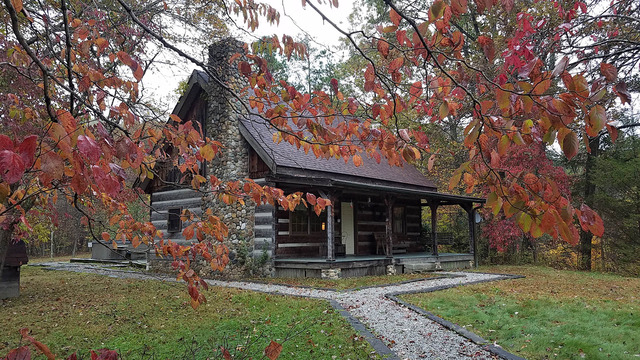BLUE ROCK STATE PARK
Rugged hills and rich green forests provide the backdrop to Blue Rock State Park. Escape to nature's solitude, and enjoy the diverse flora and fauna of this scenic state park.
The origin of Ohio's bedrock materials can be traced back millions of years when the state was inundated by a shallow inland sea. Materials deposited by this sea formed the bedrock types now found in Ohio--namely limestone, shale and sandstone. The silt from these waters formed the sedimentary shale found within the Blue Rock State Park region. This blue-colored shale gave the park its name.
Before settlement of the area began, most of Ohio was in forest cover. By 1900, only twelve percent of the original forest remained. In the Blue Rock region, the rough terrain, poor soils and the economic woes caused by the Great Depression forced farmers to abandon their lands allowing them to revert back to forest. The Ohio Department of Natural Resources now maintains 4,573 acres of the Blue Rock State Forest surrounding the park. The forest is dominated by oaks and hickories. In the lush undergrowth, woodland wildflowers such as trilliums, cardinal flower and rare orchids can be found amongst a variety of ferns, mosses and lichens. Deer, grouse, squirrel and wild turkey are just a few of the woodland game which make the forest their home.
Years before this beautiful region was known to the white man, the great Shawnee Nation built Old Town, the village of Chief White Eyes, near present-day Duncan Falls on the Muskingum River. For years, White Eyes was on friendly terms with the white man including the adventurous trapper named Duncan who was permitted by the chief to hunt, trap and trade with them. Duncan became enraged when he found game was being stolen from his traps by a hostile band of Indians from across the river. Duncan began to shoot all Indians who meddled with his traps until he himself was shot by the hostiles while crossing the river at a low spot. His body was found on a gravelly ripple now called Dead Man's Ripple, and the falls at that spot are called Duncan's Falls because it was there that Duncan fell.
Rich coal deposits were discovered in the area. By utilizing the Muskingum River for transporting the coal, a prosperous mining industry soon developed.
In 1856, this area was shaken by one of the most remarkable mine disasters in history. The collapse of the mine happened about 11 a.m. on Friday, April 25, 1856. It was soon discovered that four persons were either imprisoned or crushed to death inside the mine. A dangerous rescue attempt began at once combining the greatest speed with the utmost caution possible. The rescue continued night and day with varying success. An immense crowd of people from the surrounding countryside and towns gathered at the mouth of the mine to offer help, encouragement and prayers for the imprisoned men. At 11 p.m., on Friday, May 9, after having been entombed for fourteen days, the men were reached and brought to safety--alive!
To the north of Blue Rock lies the city of Zanesville, Ohio's state capital from 1810 to 1812, and a leader in the manufacture of clay products. Several potteries still exist. In 1796, Congress gave Ebenezer Zane authority to construct a road from Wheeling to Maysville, Kentucky. The point where the road, known as Zane's Trace, crossed the Muskingum River became the site of Zanesville--named for Ebenezer Zane.
In 1936, the state of Ohio purchased the lands comprising Blue Rock State Forest. Construction of Cutler Lake was completed in 1938. Blue Rock officially became a state park with the formation of the Division of Parks and Recreation in 1949.
Ohio does not have an annual pass and does not charge entrance fees to state parks.
GeneralLand, acres322
Water, acres15
Nearby State Forest, acres4,573
Day-UseFishingyes
Huntingyes
Hiking Trail, miles3
Picnickingyes
Picnic Shelters, #3
Swimming Beach, feet250
Bridle Trails, miles26
Beach Concessionyes
Nature Programsyes
BoatingBoating Limits-1
Launch Ramps, #1
CampingPrimitive, #97
Pets Permittedyes
Dumpstationyes
Rent-A-Camp Sites, #3
Camper Cabins, #3
Group Camp, capacity120
Walk-In Campsites, #20
WinterSleddingyes
Ice Skatingyes
Ice Fishingyes
There are 101 non-electric campsites available for tent or trailer camping in two separate areas near the lake. Pet camping is permitted on designated sites. Latrines, picnic tables, water, dump station, fire rings and playgrounds are provided. Coin-operated warm showers are available to campers at the beach bathhouse. Three Rent-A-Camp units consisting of a tent, sheltered picnic table, cooler, cookstove and other equipment can be rented during the summer months. Three camper cabins are also available with campstove, lantern and cooler provided. A group camp is available by reservation for organized groups only. A primitive camp area is also available. This walk-in "tents only" area is off Cutler Lake Road. Register for campsites at the camp store, where snack foods, camp supplies, sundries, souvenirs, ice and firewood can be purchased in season.




